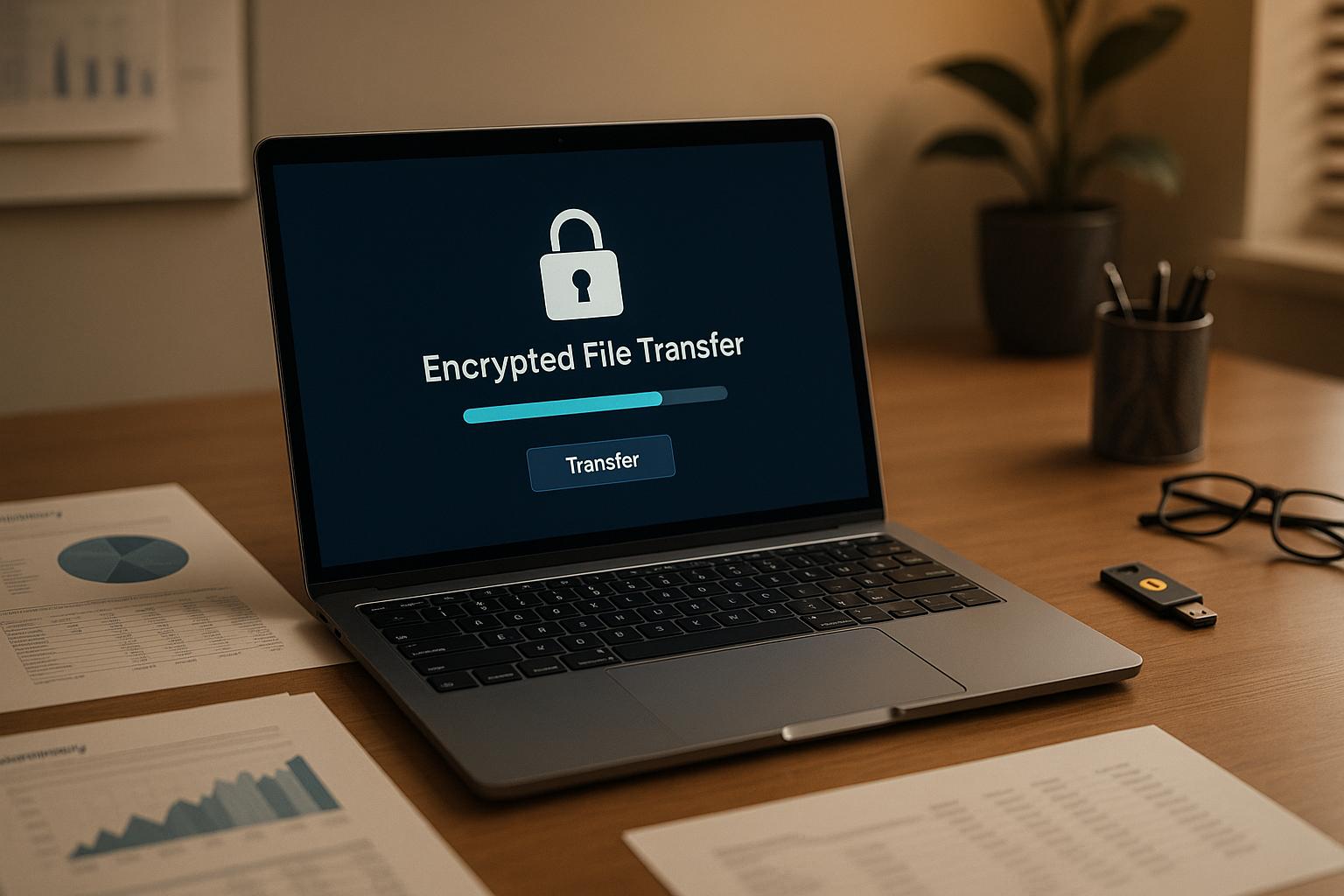Best Practices for Secure File Transfers in Finance

Secure file transfers in finance are critical because they protect sensitive data like Social Security numbers, bank details, and credit card information from breaches. With the financial sector facing 744 data breaches in 2023 and average breach costs exceeding $6 billion in 2024, the stakes are high. Errors, such as misdirected emails, account for 84% of breaches, while cyber threats like ransomware and phishing continue to rise.
To address these risks, financial institutions must adopt strategies like encryption, multi-factor authentication (MFA), Zero Trust security models, and managed file transfer (MFT) solutions. Key steps include:
- Encryption: Use AES-256 for stored data and TLS 1.3 for data in transit.
- Authentication: Strengthen access controls with MFA and certificate-based systems.
- Zero Trust: Treat every user and device as a potential risk, verify all access, and monitor for unusual activity.
- MFT Solutions: Centralize file transfers with audit trails, automation, and compliance tools.
Main Challenges in Secure File Transfers
Financial organizations face a tangled web of challenges when it comes to securing file transfers. Tackling these issues requires a well-thought-out, multi-layered approach.
Regulatory Compliance and Data Privacy
The financial sector operates under some of the strictest regulatory frameworks, with organizations needing to juggle multiple overlapping rules. Each regulation comes with its own set of requirements for how data is handled and transferred.
For instance:
- GDPR: Imposes hefty fines for violations and emphasizes audit trails, data residency, and privacy by design.
- SOX: Requires public companies to maintain strict controls over financial reporting data, including detailed access logs.
- PCI DSS: Mandates specific encryption standards for transmitting credit card data.
- CCPA: Demands clear procedures for handling personal information belonging to California residents.
Cross-border data transfers add another layer of complexity, as different countries enforce varied data residency laws. On top of that, state-level banking regulations in the U.S. create additional compliance challenges for institutions operating across several states. And while staying compliant is already a tough job, the constant evolution of cyber threats makes secure file transfers even more challenging.
Cybersecurity Threats
Beyond regulatory hurdles, financial institutions must contend with an ever-changing cybersecurity landscape. Attackers are constantly refining their methods, often outpacing traditional defenses.
Some of the most pressing threats include:
- Business Email Compromise (BEC): Criminals impersonate trusted individuals to trick employees into sending sensitive files to unauthorized recipients, causing significant financial damage.
- Man-in-the-Middle Attacks: Weak or unsecured encryption can allow attackers to intercept and manipulate data during transfers.
- Insider Threats: Authorized personnel might misuse their access to bypass security controls.
- Advanced Persistent Threats (APTs): Long-term campaigns aimed at infiltrating networks and exfiltrating data.
- Supply Chain Attacks: Exploiting vulnerabilities in third-party systems to compromise security.
Emerging technologies like AI have also upped the ante. AI-powered attacks make phishing emails and fake communications more convincing than ever. Meanwhile, zero-day exploits expose vulnerabilities in file transfer software before fixes are available. And as more employees rely on mobile devices for remote access, lax security on these devices creates additional weak points.
The combination of strict regulations and increasingly sophisticated cyber threats underscores the importance of adopting a layered security strategy for financial file transfers.
Best Practices for Secure File Transfers in Finance
Dealing with regulatory requirements and cyber threats demands a layered approach to security. From powerful encryption methods to rigorous user authentication and advanced management tools, financial institutions can implement strategies to protect sensitive file transfers. These measures combine to create a robust defense against external attacks and internal risks.
Encryption and Multi-Factor Authentication
Encryption is the cornerstone of secure file transfers. Financial institutions should use AES-256 encryption to safeguard data at rest and TLS 1.3 to protect data during transit. This dual-layered encryption ensures that sensitive information remains secure, whether it's being stored or transmitted.
For maximum security, encrypt files at every stage - before transfer, during transit, and at rest. Even if attackers intercept the data, they won't be able to access it without the appropriate decryption keys.
Adding multi-factor authentication (MFA) strengthens user verification. Methods like biometrics, hardware tokens, or mobile confirmations make it much harder for unauthorized users to gain access, even if login credentials are compromised through phishing or other attacks.
For automated file transfers between systems, certificate-based authentication provides an additional layer of security. Digital certificates verify the identity of both the sending and receiving systems, eliminating the need for shared passwords that could be exploited.
These encryption and authentication measures form the foundation of a secure file transfer strategy.
Using a Zero Trust Security Model
The Zero Trust model operates on a simple but critical principle: "never trust, always verify." In the world of file transfers, this means treating every user, device, and network connection as a potential risk until proven otherwise.
Under a Zero Trust policy, every transfer request is verified based on factors like user identity, device type, location, time, and the nature of the data. For example, if a user tries to access files from an unexpected location or requests an unusually large amount of data, the system can block the transfer or prompt for additional authentication.
Microsegmentation adds another layer of protection by limiting access to specific data zones. Instead of granting broad network access, users are restricted to the data they need. For instance, an accounting team member might only access payroll files, while investment analysts are limited to portfolio data. This compartmentalization minimizes potential damage if an account is compromised.
Real-time monitoring is a key element of Zero Trust. Systems continuously analyze user behavior and flag unusual activity. If someone who typically transfers small files suddenly attempts to move large quantities of customer data, the system can halt the transfer and alert the security team.
By combining these principles with advanced tools, organizations can enhance their security posture.
Use Managed File Transfer (MFT) Solutions
Managed File Transfer (MFT) solutions offer a centralized and secure way to manage sensitive file transfers. Unlike basic file-sharing tools, these platforms are tailored to meet the demanding security and compliance standards of the financial industry.
MFT platforms provide detailed audit trails, tracking every aspect of a file transfer - who sent it, who received it, when it occurred, the security protocols used, and whether the transfer was successful. These logs are invaluable for regulatory audits and security reviews.
Automated compliance features simplify adherence to evolving regulations. MFT systems can automatically apply specific security controls based on the type of data being transferred. For example, personal customer data might trigger compliance with GDPR, while credit card information activates PCI DSS protections. This automation reduces the need for manual oversight.
MFT solutions also streamline processes with automated workflows. High-value transactions can be set to require managerial approval, while routine reports are sent directly to designated recipients without delays or errors.
Integration is another strength of MFT platforms. They can seamlessly connect with enterprise resource planning systems, customer relationship management tools, and core banking applications. This eliminates the need for manual data transfers, reducing both security risks and operational inefficiencies.
A centralized dashboard gives security teams a comprehensive view of all file transfer activities. They can quickly identify unusual patterns, investigate potential issues, and generate compliance reports - all without juggling information from multiple systems.
sbb-itb-e766981
How to Set Up Secure File Transfer Solutions
Setting up secure file transfer systems involves more than just following best practices; it’s about creating a configuration that aligns with both regulatory demands and operational goals. Financial organizations, in particular, need solutions that balance security, efficiency, and scalability to keep up with evolving business needs.
Selecting the Right Tools and Features
The first step in creating a secure file transfer setup is selecting platforms that use industry-standard protocols. Protocols like SFTP (SSH File Transfer Protocol) and FTPS (File Transfer Protocol Secure) are essential because they encrypt data during transmission and provide authentication, unlike basic FTP.
Another crucial feature is data loss prevention (DLP). Look for systems that automatically scan files for sensitive information like Social Security numbers, credit card details, or account numbers. These solutions should block or quarantine unauthorized data transfers before they leave your network, preventing potential breaches.
Monitoring tools are equally important. Your system should track file sizes, transfer frequency, user locations, and access patterns. For example, if a user attempts to transfer files at odd hours or from an unusual location, the system should flag the activity and alert administrators immediately.
Ensure your solution supports API integration for seamless connectivity with existing systems and offers granular permission controls. Different roles require different access levels. For instance, a junior employee might only need to receive reports, while a senior manager may need the ability to send sensitive documents to external auditors.
To simplify regulatory compliance, choose platforms with built-in compliance reporting features. These should generate audit logs that meet standards like SOX or PCI DSS and allow for easy export and search during regulatory reviews.
Storage and file size limitations are another consideration. Financial institutions often deal with large datasets, so make sure your system can handle your typical file volumes and sizes without slowing down.
Once you’ve chosen the right tools, the next step is integrating them into your IT infrastructure.
Scalability and System Integration
For secure file transfer systems to work effectively, they must integrate seamlessly with your existing workflows and scale to meet future demands. Begin by mapping your current data flows to understand how files move between internal departments, external partners, and regulators. This helps pinpoint integration needs and potential bottlenecks.
Single sign-on (SSO) integration is a smart way to enhance security and simplify user management. By connecting your file transfer platform to your identity management system, employees can use their regular corporate credentials, reducing the risks associated with managing multiple passwords.
Plan for horizontal scaling from the outset. As your organization grows, your system should handle more users, larger files, and higher transfer volumes. Cloud-based platforms often offer automatic scaling, while on-premises setups may require additional hardware investments to accommodate growth.
Don’t overlook backup and disaster recovery planning. Your file transfer solution should work with your existing backup systems and support geographic redundancy. This ensures that if your main data center goes offline, file transfers can continue through secondary systems without disruption.
To avoid network slowdowns, look for systems with bandwidth management features. These allow you to prioritize critical business applications and ensure that large file transfers don’t interfere with other operations.
As remote work becomes more common, mobile device support is increasingly important. Choose solutions with secure mobile apps or web interfaces that provide the same level of encryption, authentication, and monitoring as desktop systems.
Before deploying the system organization-wide, conduct thorough testing. Start with a pilot program involving a small group of users. This helps identify integration issues, performance bottlenecks, and training needs before rolling out the solution to everyone.
Implementing change management processes is key to a smooth transition. Offer training for both end users and IT staff, and provide easy-to-access documentation and guides to address common questions.
Finally, keep improving your setup by monitoring its performance regularly. Track metrics like transfer speeds, system uptime, user adoption, and security incidents. These insights can help you fine-tune the system and make a strong case for future upgrades or enhancements.
Conclusion: Key Points and Future Trends
Artificial intelligence is set to transform secure file transfers in the financial sector by reshaping how data is moved and protected. With the ability to adjust dynamically to network conditions, AI will improve both the speed and reliability of transfers. At the same time, its continuous monitoring capabilities will detect anomalies and respond to threats automatically, creating a more secure environment.
As quantum computing continues to advance, quantum-resistant encryption will likely become the new standard. AI will play a critical role in developing and managing these encryption methods, helping financial institutions stay ahead of emerging security challenges.
FAQs
How does the Zero Trust model improve the security of file transfers in financial services?
The Zero Trust security model enhances file transfer security in the financial sector by adhering to the belief that no user or device should ever be automatically trusted - whether they're inside or outside the network. Instead, it enforces ongoing verification of user identities, device status, and access permissions before any data transfer is approved.
Core practices include encrypting data during transit and while stored, implementing multi-factor authentication (MFA) to verify user access, and using strict access controls to block unauthorized entry. This approach helps reduce risks from both insider threats and external cyberattacks, keeping sensitive financial data secure while meeting regulatory compliance standards.
What key features should financial institutions prioritize in a Managed File Transfer (MFT) solution to ensure regulatory compliance?
When selecting MFT solutions, financial institutions need to focus on tools that deliver detailed audit trails, thorough activity logs, and automated compliance reporting. These features are essential for meeting regulatory demands such as PCI DSS, GDPR, and SOX, while also ensuring accountability and clarity throughout file transfer operations.
Equally important are features like secure data encryption, scalability, and automation capabilities. Reliable timestamps and precise user activity tracking play a key role in adhering to industry standards and protecting sensitive financial information.
How can financial organizations ensure secure file transfers while accommodating remote work and mobile device use?
Financial institutions can safeguard file transfers by employing layered security measures that protect data both in transit and at rest. This includes leveraging secure remote access tools, VPNs, and encryption protocols to shield sensitive information. Encrypting files prior to sharing and relying on end-to-end encrypted platforms are also critical steps in maintaining security.
When it comes to managing mobile devices, organizations should establish mobile device management (MDM) policies. These policies help regulate access, block unauthorized downloads, and keep an eye on device activities. Not only do these practices strengthen security, but they also enable the flexibility required for remote work, balancing operational efficiency with strong data protection.




